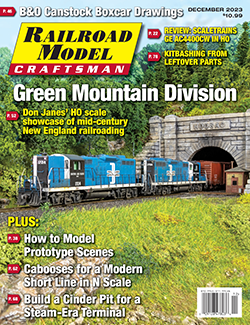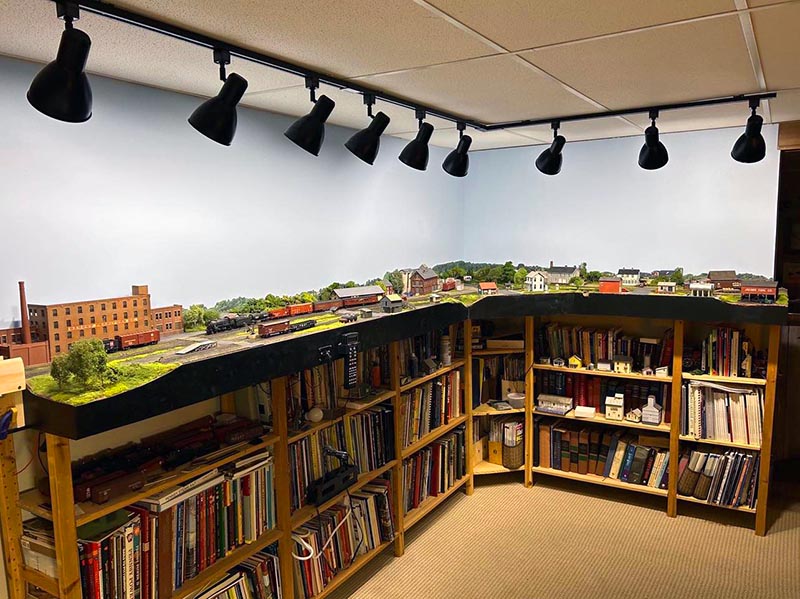 Many years ago, hobbyist Frank Ellison famously wrote that model railroading is like theater. He’s right in many ways: staging yards, for instance, add to a model railroad’s dramatic impact by allowing trains to enter and leave the layout like an actor’s entrances and exits.
Many years ago, hobbyist Frank Ellison famously wrote that model railroading is like theater. He’s right in many ways: staging yards, for instance, add to a model railroad’s dramatic impact by allowing trains to enter and leave the layout like an actor’s entrances and exits.
However, there’s one aspect of theater that’s important to us as model railroaders, but is sometimes neglected. It’s called “suspension of disbelief.” Everyone who works in the entertainment industry tries to help audience members leave the real world for a short while and accept, at least a little, that what they’re watching is real rather than a play or movie.
This is really hard to do. People are naturally skeptical, and the slightest flaw or distraction can prevent us from believing what we’re seeing. I’m getting ready to build a new layout, and if I want visitors to accept my world in miniature, I’ll need to create a believable environment. Here are a few things I want to avoid during design and construction.
Sometimes, when visiting a layout for the first time, the first thing I encounter at the bottom of the basement stairs is unscenicked staging or the workshop. This is just like being made to enter a theater by the door next to the dumpster, and walk through the backstage area to get to my seat. Once the curtain goes up, it’s hard to forget that image and believe in the on-stage action.
Showing a visitor an attractive finished scene first thing will enhance your illusion of realism rather than destroying it. If the path into an existing layout room can’t be rerouted, subdued lighting and simple screens or drapes will keep these areas from being distracting on operating nights or during open houses. Even the Wizard of Oz used a curtain, after all.
Unless safety is a consideration, a well-lit layout with darkened aisles is a great idea that helps de-emphasize distractions. This is another trick from the world of the theater — a movie would be a lot less pleasant to watch, for instance, if they didn’t dim the house lights.
Even if the finished part of your model railroad looks great, a visitor sees its whole environment — cobweb-covered ceilings, unpainted concrete block walls, and lots of untidy boxes crammed under the layout. Each one keeps the viewer from being drawn into the scene.
Every visible surface should be finished or concealed in some way. The photo shows a corner of the basement in my former house turned into a pleasing layout space. All it took was four sheets of hardboard, a few feet of trim molding, and some paint.
Model railroaders have a dizzying variety of kits from which to choose. The majority of model railroads can use the same type of rolling stock and locomotives, but structures are largely left for us to select — and to help the viewer suspend his or her disbelief, our layouts’ structures should be regionally and prototypically appropriate, distinctive, and unique.
You don’t get any of that from common off-the-shelf structure kits, though. A popular design from a large manufacturer may sell hundreds of thousands of kits over its lifetime. The same structure, built straight out of the box and perhaps even unpainted, can be found on thousands of model railroads. Spotting one on someone’s layout destroys the illusion of realism in an instant.
Consider instead the offerings from smaller manufacturers, who all produce terrific models with unique designs. A look through the ads here in RMC will turn up dozens of them — and they aren’t the same kits you’ll find on everyone else’s layout. Kitbashing and scratchbuilding are also very useful if you need to disguise a kit’s commercial origins, make it resemble a prototype more closely, or fit into a particular space.
Color and texture are vital to the realism of any model or layout. Subdued colors, stains and washes, pastels and weathering powders, and all the other techniques we see in the model press, turn an out-of-the-box kit into a model which is realistic and unique to your railroad. After a few minutes operating or railfanning, you may forget that it’s a model. And that’s the effect we’re striving for.
To capture and hold the attention of our layouts’ operators and visitors, we have to give them the chance to suspend their disbelief. I’m going to try to keep this thought in mind with each step in the process of designing and building my new layout.
—Paul Boehlert



